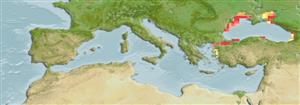Common names from other countries
>
Acipenseriformes (Sturgeons and paddlefishes) >
Acipenseridae (Sturgeons) > Acipenserinae
Etymology: Acipenser: Latin, acipenser = sturgeon, 1853 (Ref. 45335); gueldenstaedtii: Named for Johann Anton Güldenstädt (1745-1781).
Eponymy: Professor Johann Anton Gueldenstaedt (or Güldenstädt) (1745–1781) was a Baltic-German, born in Riga (Latvia), then part of the Russian Empire. [...] (Ref. 128868), visit book page.
Issue
Acipenser colchicus was described as a subspecies of A. gueldenstaedti, then considered as a subspecies of A. persicus, and is now recognized as a species by some works. On the other end, other works suggest that A. persicus, which is similar to A. gueldenstaedti, is a synonym of the latter. We will wait that the taxonomoic situation gets more clarity before changing the list of valid species, which follows the World Sturgeon Conservation Society one. Check ECoF, IUCN and FAO for more details. Anyway in FishBase, it is possible to retrieve the information under the name that was used as valid in each publication.
Environment: milieu / climate zone / Tiefenbereich / distribution range
Ökologie
seewasser; süßwasser; brackwasser demersal; anadrom (Ref. 51243); tiefenbereich 2 - 100 m, usually 10 - 25 m. Temperate; 10°C - 20°C (Ref. 2059); 61°N - 35°N, 26°E - 54°E
Eurasia: Black Sea, Sea of Azov and Caspian Sea basins. Introduced throughout Europe.
Length at first maturity / Size / Gewicht / Alter
Geschlechtsreife: Lm ? range ? - ? cm
Max length : 236 cm TL Männchen/unbestimmt; (Ref. 59043); common length : 145 cm TL Männchen/unbestimmt; (Ref. 3561); max. veröff. Gewicht: 115.0 kg (Ref. 6866); max. veröff. Alter: 46 Jahre (Ref. 3561)
Rückenflossenstacheln (insgesamt) : 0; Rückenflossenweichstrahlen (insgesamt) : 27 - 48; Afterflossenweichstrahlen: 16 - 35. Under the name A. g. colchicus. Lower lip not continuous, interrupted at center. Five rows of scutes: dorsal 7-19, lateral 24-44 on each side, ventral 6-13 on each side, with lines of smaller stellate bony plates between the dorsal and ventral rows. Color of back olivaceous grey, flanks lighter, and belly white.
Body shape (shape guide): elongated; Cross section: circular.
Anadromous and freshwater populations exist. At the sea, it occurs in shallow coastal and estuarine zones. In freshwaters, it inhabits deep parts of large rivers with moderate to swift current (Ref. 59043). Found mainly near the shore over sand and mud. Usually solitary, but swarms when hibernating or during spawning migrations. Occasionally forms schools (Ref. 3241). Feeds on benthic molluscs, crustaceans and small fishes. Spawns on stone or gravel bottom in large and deep rivers with strong current, 1-1.5 m/s (Ref. 59043). Mainly propagated through artificial reproduction.
Under the name A. g. colchicus. Spawns in rivers. Natural spawning not extensive, maintained chiefly by artificial propagation. Enters rivers from April to June (a few in autumn).
Sokolov, L.I. and L.S. Berdicheskii, 1989. Acipenseridae. p. 150-153. In J. Holcík (ed.) The freshwater fishes of Europe. Vol. 1, Part II. General introduction to fishes Acipenseriformes. AULA-Verlag Wiesbaden. 469 p. (Ref. 9953)
IUCN Rote Liste Status (Ref. 130435: Version 2025-1)
Bedrohung für Menschen
Harmless
Nutzung durch Menschen
Fischereien: kommerziell; Aquakultur: kommerziell; Aquarium: Öffentliche Aquarien
Tools
Zusatzinformationen
Download XML
Internet Quellen
Estimates based on models
Preferred temperature (Ref.
123201): 10.7 - 15.9, mean 13.8 °C (based on 32 cells).
Phylogenetic diversity index (Ref.
82804): PD
50 = 0.5000 [Uniqueness, from 0.5 = low to 2.0 = high].
Bayesian length-weight: a=0.00417 (0.00256 - 0.00679), b=3.12 (2.99 - 3.25), in cm total length, based on LWR estimates for this species & Genus-body shape (Ref.
93245).
Trophic level (Ref.
69278): 3.3 ±0.1 se; based on diet studies.
Widerstandsfähigkeit (Ref.
120179): sehr niedrig, Verdopplung der Population dauert mehr als 14 Jahre. (tm=11; tmax=46; Fec = 26,000).
Fishing Vulnerability (Ref.
59153): Very high vulnerability (87 of 100).
🛈
Climate Vulnerability (Ref.
125649): High vulnerability (62 of 100).
🛈
Nutrients (Ref.
124155): Calcium = 14.6 [8.4, 25.7] mg/100g; Iron = 0.247 [0.150, 0.396] mg/100g; Protein = 17.4 [14.9, 20.1] %; Omega3 = 0.342 [0.189, 0.611] g/100g; Selenium = 23.6 [12.0, 45.3] μg/100g; VitaminA = 5.63 [1.97, 16.00] μg/100g; Zinc = 0.512 [0.365, 0.722] mg/100g (wet weight);
